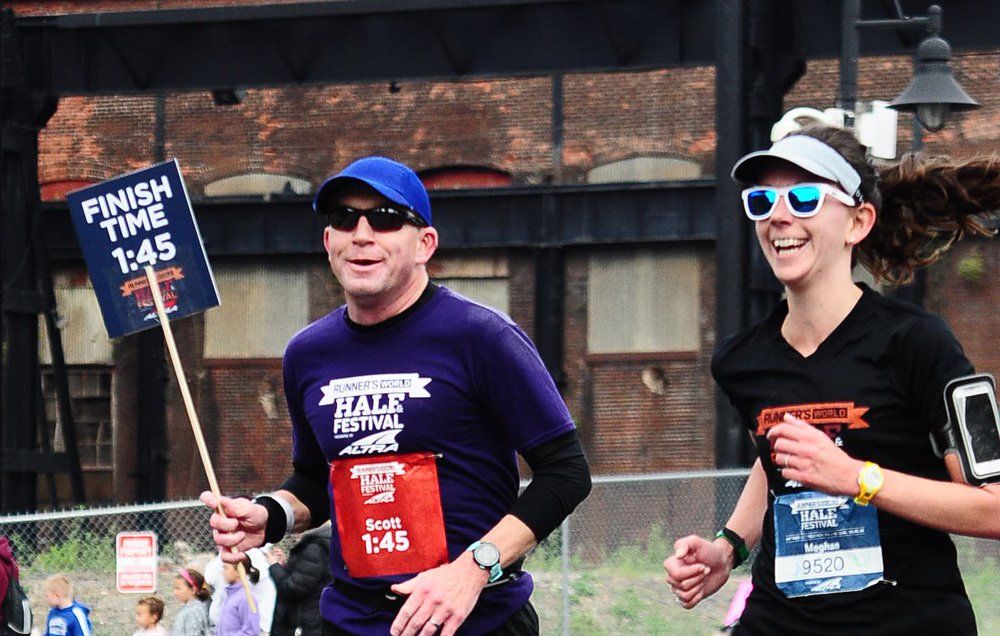Perhaps this has happened to you: You’re grinding it out in a race, working your hardest to maintain a tough pace, and you pass someone who’s walking. Within the next minute, the same person runs past you. Within a mile or so, you catch them walking again and pass them again.
Somehow this game of leapfrog goes on and on for the rest of the race.
This hypothetical person is likely using the run-walk method, a training and racing technique popularized by Olympian and running coach Jeff Galloway. The run-walk method involves running for a predetermined length of time, taking a planned walk break, and repeating. The purpose of the walk break is to reduce stress on the body and mind.
The run-walk method is often associated with beginners, but more experienced runners can (and do) use it. I encountered my first run-walker in the final miles of the 2011 Disney Princess Half Marathon. I ran a PR (at the time) of 1:41:48, and the run-walker finished right on my heels. The leap-frogging irritated me at the time, but I was definitely intrigued.
After a string of bad marathons, this method made me even more curious. Maybe walk breaks during a marathon could help me take in and digest midrun fuel (a big problem for me), which would help me race the run portions stronger. Before I ventured to trying this in a full 26.2, I wanted to test it in a shorter event first, and the 2016 Runner’s World Half Marathon in Bethlehem, Pennsylvania, seemed like the perfect opportunity.
I had a lackluster year of training and racing that included few long runs, even fewer tempo runs, and even fewer runs on terrain similar to the course (that is, nonstop ups and downs), so I wasn’t sure what kind of time to expect. I figured I could break 1:50—which I could achieve if my running segments were around 8:00 pace—but I thought sub-1:45 might be too optimistic. Here’s what happened.
I felt ridiculous at times.
I have considered “not stopping to walk” a sign of mental victory in tough races since I began running in high school 14 years ago, so I felt extra silly stopping at the first mile marker. (My run-walk strategy was to walk one minute at a normal walking pace after every mile marker—a tactic 1968 Boston Marathon winner and former RW editor-in-chief Amby Burfoot wrote about using back in the ’90s.)
There was a big cheer group stationed near mile 1, and they didn’t seem to know what to make of me. The same thing happened at mile 12—I got a few half-hearted cheers of the “You can do it!” variety, but because I didn’t appear to be riding the struggle bus, people weren’t sure how to react. (I didn’t stop after mile 13 because I would have been walking over the finish line, basically.)
Other runners were more curious than irritated.
I realized early on that I was going to be playing leapfrog with the 1:45 pace group, a large mass of people aiming for an ambitious goal on a tough course. Around mile 4 or 5, people started asking me about what I was doing. "
I explained that I was experimenting for an online story. A few people were impressed that I was keeping up with their group despite walk breaks. A few others shared stories like, “I know a guy who qualified for Boston using walk breaks,” or, “I run-walked back when I was trying to break 4:00 in the marathon for the first time.” Thanks for your patience and understanding, other runners!
I got a story idea.
The RW Half course includes very few flat stretches. You’re either climbing or descending for the bulk of the race. Some of the mile markers were located on descents, and it felt like a waste slowing to a walk when I could be using gravity to carry me.
I still stopped at each marker until mile 11, which hit a few hundred yards before the base of a hill. There, I ran through the marker, then walked for a minute when it flattened out. “I should ask Jeff Galloway if advanced runners should take course layout into account when planning a run-walk strategy for a race,” I thought. I edit his column in the magazine, so perhaps you’ll see that question answered in an upcoming issue.
My gel sat better.
Because of my aforementioned lackluster training, I haven’t taken a gel since May, when I ran the Brooklyn Half with a friend. I’ve done a handful of easy 10+ mile runs since that race, but I fueled them with a large breakfast beforehand.
My stomach was not trained to take gel at all, especially not while running tempo pace (about 7:15 to 7:30 pace for me). So, I took my gel during my mile 8 walk break and washed it down with some water at the next aid station. Usually midrace gels make me feel like I’m going to throw up, even when I’ve trained with them, so not feeling that way during this race was a step in the right direction.
I finished much faster than I thought I could.
At the RW Half, all of the RW editors are labeled as such with bibs we wear on the back of our shirts. I tend to be a cranky racer—especially in the final miles—so I’ve always been afraid to run any of our races all-out: What if I snap at someone who’s just trying to chat with me while I am supposed to be representing the brand? The walk breaks took the crankiness out of the equation.
It was like hitting the reset button every mile. I would start to feel like I was working hard, to begin entering that negative headspace…but then a walk break would wipe the slate clean. As such, I was still laughing at funny signs and saying hi to people I recognized and smiling at the on-course entertainment through the final straightaway.
And while my finishing time (1:43:28) was not all that close to my PR (1:36:33), it was a whole lot faster than I expected or deserved to run given how poorly I prepared and the difficulty of the course. If I had run the entire way, I might have finished a minute or two faster, but I would have really suffered for it—and I might have been a not-so-nice person along the way.
If you're curious about run-walking, check out this article or JeffGalloway.com.













